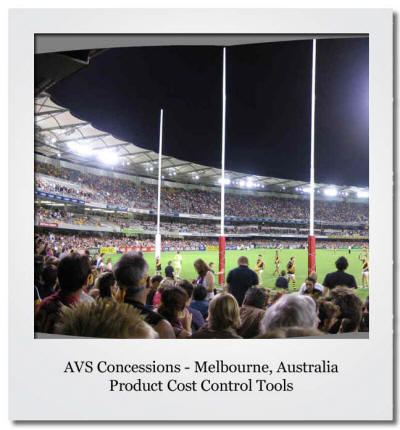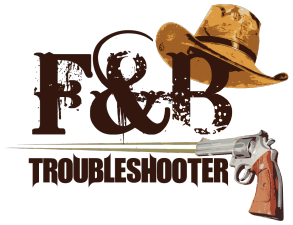
AVS Catering Ė Melbourne, Australia
 Delaware
North Companies Australia purchased a small sports
concessions company located in Melbourne, Australia. It
consisted of a half dozen Aussie Rules Football Stadiums,
the Australian Tennis Stadium, a couple of museum
cafeterias, and the Melbourne Zoo. Management was concerned
that product cost at the venues was running high and wanted
DNCís PC based back of the house inventory systems to be
implemented in the Melbourne venues. I was asked to travel
to Australia, live there for three months, and implement
these systems in the six largest venues.
Delaware
North Companies Australia purchased a small sports
concessions company located in Melbourne, Australia. It
consisted of a half dozen Aussie Rules Football Stadiums,
the Australian Tennis Stadium, a couple of museum
cafeterias, and the Melbourne Zoo. Management was concerned
that product cost at the venues was running high and wanted
DNCís PC based back of the house inventory systems to be
implemented in the Melbourne venues. I was asked to travel
to Australia, live there for three months, and implement
these systems in the six largest venues.
I met with AVSís General Manager at the Australian Football
Stadium and explained the purpose of my two week visit to
his facility. I explained how the various inventory control
software packages worked and how they would help him to
manage his business.
Since a large percentage of sales was concessions food and
beer, I started with the concessions package. I set up each
concessions item with the description, sales price, unit
cost, etc. I trained the office manager to enter all
purchases into the concessions system when the products were
received, spoilage as it occurred, employee meals, and the
ending inventory at the end of the inventory period (second
and last week of the month). When used properly, the
software would calculate product yields, product cost, cost
of employee meals, and cost of spoilage.
The next software package that I implemented was the Bar
Reports. I set up the Liquor Room, Wine Cellar, and Main
Beer Cooler on a perpetual inventory system where the Bar
Manager would know by looking at the report how much
inventory he had in stock. He could tell at a glance how
many bottles of each liquor brand he had in the liquor room,
how many bottles of each wine brand he had in the wine
cellar, and how many kegs and bottles of beer he had in the
main beer cooler.
Each bar was set up on its own bar report. Every bottle of
liquor, beer, and wine was tracked from the time it was
received from the Vendor into the Beverage Warehouse until
it was issued to a bar. At the end of the inventory period,
the liquor, beer, and wine was counted in the Beverage
Warehouse and in each bar. When the Bar Reports were
completed properly, management would know the Liquor Cost
Percentage, Beer Cost Percentage, and Wine Cost Percentage
at each bar.
The third software package I implemented was the Menu Mix.
Each menu item was listed on Cost Specification Sheets,
broken down into its ingredients, and the cost of those
ingredients were calculated. The selling price and total
cost of each menu item was input into the Menu Mix software.
Each day, the number of items sold was entered into the Menu
Mix. At the end of the month, the Menu Mix software
calculated the Theoretical Food Cost Percentage for the
items sold during the month. The Dining Room Manager would
compare the Theoretical Food Cost Percentage to the Actual
Food Cost Percentage on the P&L. Any variance greater than
two percentage points was investigated.
The final software package that I implemented was the Food
Inventory software. Back in the 1990ís, a lot of Food and
Beverage companies were still manually extending food
inventories. I set up all food items from the fine dining
kitchens and storerooms in the software. Prior to the
inventory, I printed count sheets that had all items listed.
The counters would enter the counts on the count sheet and
the Office Manager would key the counts. When everything was
entered, the software would calculate the inventory by Dry
Goods, Baked Goods, Dairy, Produce, Meat, Fish, etc, and a
Total to record in the General Ledger.
After I had implemented the inventory control software,
management had tools in place to detect problems with Food
Cost, Liquor Cost, Beer Cost, and Wine Cost. They could
isolate the cause of a problem and take prompt corrective
action to resolve the issues. As a result, there was a
noticeable improvement in Product Cost at the six venues
utilizing the software. Once familiar with how the software
worked, the Aussies were able to install the software in the
remaining venues.
(RETURN)
